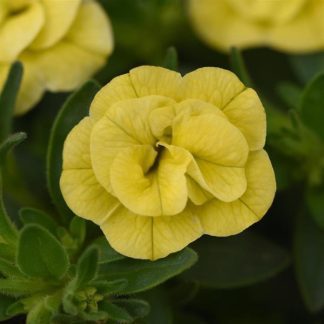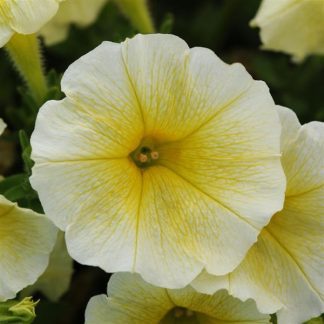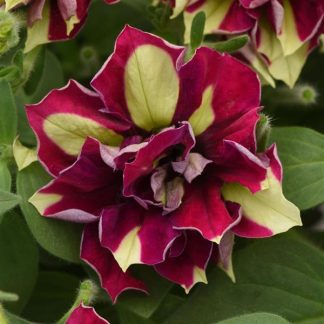Description
Easy Wave Red Petunia: A Sea of Scarlet Made Simple
Welcome to the Wave
You want color that never quits. We all do. That strong splash of scarlet lifts spirits, gathers compliments, and turns a plain porch into a bright, happy place. Easy Wave Red Petunia brings that joy without the usual fussy rules. Instead of wrestling with leggy stems or guessing when to feed, you get an easy-going blooming machine. In other words, the plant works hard so you can relax, smile, and enjoy the show. Let’s dive in together and see how simple a stunning garden can be.
Meet Easy Wave Red
A Quick Snapshot
- Type: Spreading petunia, part of the famous Wave series
- Mature Size: 6–12 inches tall, 24–30 inches wide
- Bloom Time: Late spring until a hard frost
- Flower Form: 3-inch single trumpets, true candy-apple red
- Habit: Mounded at first, then spilling in graceful waves
- Best Spots: Hanging baskets, window boxes, raised beds, sunny borders
Why It Stands Out
Most petunias fade, pout, or drop petals in midsummer heat. Easy Wave Red keeps pushing new blooms day after day. We get bright color all season because breeders strengthened its weather tolerance and branching habit. More branches mean more buds, and more buds mean endless flowers. After more than twenty years of testing, the Wave series remains a bestseller for good reason: dependable performance in real-life gardens. Easy Wave Red might be the boldest of them all.
Setting the Stage
Choose the Right Container or Ground Bed
Easy Wave Red sprawls. Give it room to roam, and it will reward you. A 12- to 14-inch hanging basket handles one plant. A 16-inch patio pot can hold two or three, creating an instant dome of red. In raised beds, space plants 12–15 inches apart. This loose spacing helps air flow, beating back mildew and keeping leaves clean.
Sunlight Matters
Full sun fuels flowers. Aim for at least six hours of direct light. Eight hours is even better. If your only area gets dappled shade, blooms will still appear, but growth slows and colors soften. For that stop-you-in-your-tracks scarlet, sunny spots win every time.
Soil Prep
We start with loose, rich soil. Mix in compost or aged manure before planting. The Wave root system likes oxygen, so chunky organic matter opens tight ground. In heavy clay, amend generously or choose containers. In sandy soil, add peat or coconut coir to hold moisture. Strive for a pH between 5.5 and 6.5—slightly acidic suits petunias best.
Planting Step-by-Step
- Water seedlings first. Damp roots slide out of pots easily.
- Dig a hole the same depth as the root ball and twice as wide.
- Gently tease roots if they circle the pot. This prompts quick spreading.
- Set the plant at soil level. Burying stems invites rot.
- Backfill with amended soil, pressing lightly to remove air pockets.
- Water deeply until soil feels evenly moist from top to bottom.
- Mulch lightly with straw or fine bark. Keep mulch off stems to prevent fungus.
Everyday Care Made Simple
Watering Wisdom
Petunias drink a lot when temperatures climb. Instead of sprinkling daily, water deeply two or three times each week. Insert a finger two inches into soil. If it feels dry, it’s time. Hanging baskets dry faster than ground beds, especially on windy days. Use a watering wand to soak the root zone until water drips from drainage holes.
Feeding for Waves of Blooms
Petunias are hungry bloomers. We feed a balanced liquid fertilizer—something like 20-10-20—every seven to ten days. Some gardeners prefer slow-release pellets mixed into soil at planting. Both methods work, but liquid feeding lets you respond quickly if foliage pales. After more than four weeks of heavy rain, nutrients may leach out. Give an extra feeding to perk leaves back to deep green.
Pinching and Pruning
Early pinch, happier plant. When stems reach eight inches, nip the tips. Each pinch encourages branching, which means more flowers later. If growth turns leggy in midsummer, cut stems back by one-third. Within two weeks, new side shoots explode, and a fresh flush of blooms follows.
Deadheading—Yes or No?
The Easy Wave series is self-cleaning. Old petals drop on their own, saving time. Still, if faded blooms cling after a storm, a quick brush of the hand keeps plants tidy. Toss debris in compost to avoid mold buildup.
Troubleshooting Common Issues
Yellow Leaves
Likely cause: nutrient loss after heavy watering or poor soil. Solution: feed with a water-soluble fertilizer high in nitrogen and iron. Results appear within five days.
Wilting in Full Sun
Check moisture at root level. Hot surfaces like concrete patios heat containers quickly. Move baskets to a breezy spot or water early in the morning and again late afternoon during heat waves.
Bud Drop
Sudden cold nights may shock flower buds. Cover plants with lightweight fabric when temperatures dip below 50 °F (10 °C). They bounce back once nights warm.
Pests and Diseases
- Aphids: Hose off with a strong spray, then apply insecticidal soap.
- Spider mites: Look for fine webbing under leaves. Boost humidity and use neem oil.
- Powdery mildew: Happens in shady, crowded spots. Improve air flow, avoid overhead watering, and remove infected leaves.
Designing With Easy Wave Red
Color Companions
Red pairs well with silver, violet, and lime-green foliage. Try it with Dusty Miller, purple fountain grass, or chartreuse sweet potato vine. The contrast sparks energy instead of overwhelming the eye.
Patriotic Flair
Plant Easy Wave Red with Easy Wave White and Easy Wave Blue for instant patriotic baskets. This trio blooms together at the same height, giving balanced layers of color all season.
Sunset Mix
Blend Easy Wave Red with orange calibrachoa and yellow lantana. The warm palette echoes late-day light and invites pollinators. Bees buzz and hummingbirds hover, adding life to your display.
Beyond the Garden Bed
Living Wall Accent
Insert Easy Wave Red plugs into pockets of a vertical planter. Let vines spill over each tier, painting the wall in cascading scarlet. Water gradually from the top pocket and watch it trickle down, saving time and water.
Groundcover Glow
Need quick cover for bare soil? Space Easy Wave Red across a sloped bank. Roots knit into place, reducing erosion while flowers draw the eye away from uneven ground.
Party-Ready Centerpieces
Fill low bowls with one or two Easy Wave Red plants. Add battery fairy lights around the rim for evening sparkle. In other words, you get decor and fragrance in one easy step.
Seasonal Care Calendar
| Month | Task | Tip |
|---|---|---|
| April | Start seeds indoors 8–10 weeks before last frost | Keep lights 2 inches above seedlings |
| May | Harden off and plant after soil warms | Night temps above 55 °F are ideal |
| June | First light pruning for bushiness | Pinch tips, not large stems |
| July | Feed every 7 days | Liquid fertilizer shows results fast |
| August | Cut back if leggy | Reduce stems by one-third |
| September | Enjoy peak bloom | Deadhead by brushing with hand |
| October | Move containers inside before frost | A sunny window keeps color going |
| November | Compost spent plants | Clean pots with mild bleach solution |
Propagation Fun
While most gardeners buy transplants, you can start Easy Wave Red from seed. Sow on top of moist seed-starting mix because light aids germination. Cover the tray with a clear dome to hold humidity. Keep at 70–75 °F. Seeds sprout in 7–10 days. After more than two true leaves form, transplant into individual cells. A small fan nearby toughens stems, preparing them for outdoor life.
Cuttings also work. Take a 4-inch tip, remove lower leaves, and dip in rooting hormone. Insert into perlite or seed-starting mix. Keep warm and bright, but out of direct sun. Roots appear in two weeks. This method clones the exact plant, guaranteeing those perfect red blooms.
Eco-Friendly Tips
- Water smart. Add a saucer of water-absorbing crystals to baskets so less water drips away.
- Choose organic feeds. Fish emulsion or seaweed blends boost blooms without chemical buildup.
- Encourage pollinators. Plant Easy Wave Red near herbs like basil and dill. Their flowers lure beneficial insects that keep pests down naturally.
- Compost spent plants. Soft stems break down fast, enriching soil for next year’s crop.
Frequently Asked Questions
Q: Can Easy Wave Red handle light frost?
A: It shrugs off a gentle nip but collapses after a hard freeze. Extend color by covering plants or moving pots indoors on cold nights.
Q: Will deer eat my petunias?
A: Sometimes. Hungry deer nibble almost anything. Spray a safe repellent weekly, especially after rain.
Q: How do I stop blooms from fading?
A: Feed regularly, water consistently, and provide full sun. Heat itself does not bleach flowers, but stress does.
Q: Can I grow Easy Wave Red inside year-round?
A: Yes, under strong grow lights. Keep lights on 14–16 hours each day and pinch stems to prevent stretching.
How to Care for Easy Wave Red – Quick Guide
- Light: 6–8 hours full sun daily.
- Water: Deep soak when top 2 inches dry; avoid daily misting.
- Soil: Well-drained, fertile, slightly acidic.
- Food: Balanced liquid feed every 7–10 days.
- Prune: Pinch once early; trim back by one-third midseason if needed.
- Pests: Watch for aphids, mites, mildew; treat promptly.
- Season: Plant after frost; enjoy until a hard freeze.
With these seven steps, you and Easy Wave Red stay in perfect rhythm all season long.
Creative Project: Scarlet Surprise Ice Bowl
Turn spent petals into a table showpiece.
- Collect fresh red blooms and rinse gently.
- Fill a large bowl halfway with water; freeze.
- Place petals face-down on the ice layer.
- Center a smaller bowl on top; weigh it with stones.
- Pour water between bowls; freeze again.
- Remove bowls; display ice bowl at your next picnic, filled with fruit or drinks.
Kids love this simple craft, and guests gasp at the vivid natural color shining through the ice.
A Shared Wave of Joy Awaits
Easy Wave Red Petunia proves that bright beauty does not need hard work. When we plant smart, feed regularly, and prune lightly, waves of scarlet reward us from spring’s gentle air to autumn’s crisp breeze. Instead of worrying over wilted blooms, we gather around baskets glowing like lanterns, celebrate the season, and share stories with friends. So grab a trowel, pick your sunniest spot, and let the red tide roll into your life.




